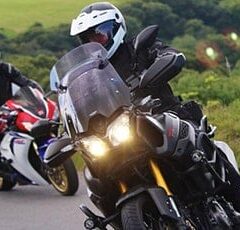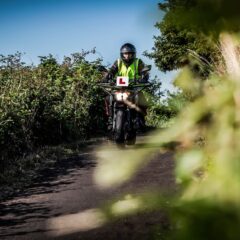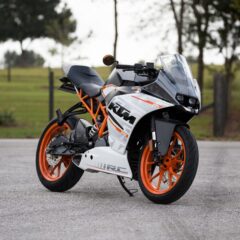
7 Top Motorcycle Accessories
With Christmas just around the corner, you might be wondering what to get your favourite motorcycle enthusiast or even a little something for yoursel...
 Phoenix Motorcycle Training LTD
Phoenix Motorcycle Training LTD
 Phoenix Motorcycle Training LTD
Phoenix Motorcycle Training LTD

Getting your full bike licence isn’t just about the destination; it’s about the incredible journey along the way. This blog will show you the fastest route to unleashing the full potential of your passion for riding. And of course, the best path to getting your very own full unrestricted motorcycle licence.
Everything kicks off with one small but crucial step: the Compulsory Basic Training (CBT) course. This is the first leg of your beginner motorcycle journey. Once you successfully complete your competency assessment, the real adventure begins!
We’ll reveal the secrets, give you invaluable tips, and introduce you to the incredible world of two-wheeled exploration. Riding a motorcycle is buckets of fun, and becoming a competent, confident and safe rider is an exciting and rewarding adventure you’ll fall in love with.
So, are you ready to ride into the unknown and embrace the world of motorcycling in all its glory? Hold on tight because the ride of your life starts here!
Your adventure to getting a full bike licence begins with Compulsory Basic Training (CBT). This step is your initiation into two-wheeled control and freedom. It’s hands-on, practical, and designed to equip you with the fundamental skills of safe road riding. During the training, you’ll learn about bike controls, road awareness, and get your first taste of on-road riding. The training lasts for the best part of a day. Your instructor will ensure you progress at a rate you’re comfortable with.
There are no written exams or nerve-wracking practical tests with the CBT assessment. Instead, your experienced instructor evaluates your ability to safely handle a motorcycle over the course of the day. Most riders, with the right guidance, pass this assessment. That shows they’re ready to hit the road.
Even though there aren’t any tests or exams, preparing for your CBT ensures a smooth experience:
Just like any journey, having the right guide is essential. When selecting a CBT instructor, prioritise experience, patience, and supportiveness. Their expertise and guidance lay the foundation for your entire motorcycling adventure. Checking out online reviews and asking friends for recommendations can help you find the best motorcycle training school for you.
Congratulations! You’ve successfully completed your Compulsory Basic Training (CBT) and have the certificate to prove it! Now, it’s time to embrace the road with your newfound confidence. But, before you hop on your bike and ride into the sunset, there are essential details you should be aware of.
Your CBT certificate grants you the freedom to ride on UK roads, but freedom comes with responsibility and in this case, specific limitations. These restrictions increase your safety as you gain more experience. Here’s what you need to know:
Your CBT certificate shows you’ve officially embarked on your path to obtaining a full bike licence. Every ride is an opportunity to grow as a rider, gain confidence, and master the art of motorcycle control. Learning to ride a motorcycle in the UK isn’t just about obtaining a piece of paper – it’s about acquiring the skills and knowledge needed to navigate the roads safely.
As you set out on your adventures with your CBT certificate in hand, keep these words in mind: Safety, Confidence, and Enjoyment. These three pillars will guide you steadily through every twist and turn on your journey to a full bike licence.
Once you’re cruising confidently on your CBT certificate, it’s time to explore the progressive approach to a full bike licence in the UK. There are two paths to a full motorcycle licence in the UK. If you’re older than 24 when you start learning to ride, you’ll be able to skip this step and jump straight to step 4.
Each phase of the motorcycle licence process comes with its own age restrictions and power limitations. Let’s take a closer look at each level:
At age 16, you can obtain an AM licence. That lets you ride mopeds, small motorcycles and scooters with a maximum speed of 28 mph (45 km/h). The engine size is restricted to about 50cc. Many young riders start here, some stick with their CBT certificate before moving to an A1 or even an A2 licence.
Once you turn 17, you can upgrade to an A1 licence. This permits you to ride motorcycles with a maximum power output of 11 kW (about 15 bhp). It’s a step up from the AM licence and a great way to build your confidence as a rider.
The A2 licence is for those aged 19 and above. It allows you to ride motorcycles with a power output of up to 35 kW (around 47 bhp or 500 to 700ccs, depending on the make and weight of the bike). It’s a significant step up and opens the door to a broader range of bikes.
Finally, the A licence is the pinnacle, granting you full bike licence status. You can get this when you’re 24 or older, or after you’ve had an A2 licence for two years. An A licence lets you ride motorcycles of any size and power, opening up a world of possibilities.
The progressive approach allows riders to gradually work their way up to a full bike licence, aligning their experience and maturity. Slowly working your way toward higher powered engines helps you build competence and confidence incrementally. This gradual progression minimizes the risk of getting in too deep too early.
If you’re over 24 years old and keen to fast-track your path to a full bike licence, the Direct Access Scheme (DAS) training is your express lane. DAS is the gateway to unlocking the full potential of unrestricted motorcycle riding at full speed.
DAS training equips you with the skills and knowledge required to handle larger and more powerful motorcycles safely. It’s a focused and intensive course that immerses you in the art of proficient riding. Not only that, the training is tailored to your experience. Your instructor will take into account any previous riding experience. Whether you’re a complete beginner or someone with some riding background, the training will be customised to meet your needs, ensuring you get the most out of it.
The length of DAS training varies because it’s based on your experience level and progress. Typically, it spans several days. That allows enough time to become comfortable and confident on bigger bikes. You don’t have to go straight to a full bike licence with DAS either, you can choose an interim step to an A1 or A2 licence if that suits you better.
So, you’ve earned your full bike licence and are now a bonafide motorcyclist. Congratulations!
But here’s the thing about motorcycling – it’s not all about collecting pieces of paper and plastic that say you’re qualified to ride. It’s an ongoing journey of improvement, learning, and getting to know yourself as a rider.
Now that you hold a full bike licence for life, it’s tempting to think you’ve reached the pinnacle of riding. But the truth is, there’s always room for improvement. Just like any other skill, riding a motorcycle benefits from continual refinement. Every time you swing a leg over your trusty machine and hit the open road, you’ll encounter new challenges, scenarios, and road conditions. Each experience is a chance to enhance your riding skills and deepen your appreciation of the art of motorcycling.
Why should you bother improving your motorcycle skills when you already hold a full bike licence? We’ve got three compelling reasons.
The more skilled you become, the better you can handle unexpected situations on the road. This can be a lifesaver when faced with sudden obstacles, adverse weather, or erratic drivers.
Some insurance providers offer discounts to riders who have completed advanced motorcycle training courses. By continually improving your skills, you could potentially reduce your insurance premiums.
There’s a unique sense of confidence that comes with knowing you’re a highly skilled rider. This confidence can translate into a more enjoyable and stress-free riding experience. Not to mention other areas of your life.
To go beyond the basics of licenced riding, enrol in an advanced motorcycle training course. These courses are designed to take your skills to the next level and address specific areas you might want to improve.
ERS courses are taught by registered DVSA instructors. You’ll focus on honing existing skills and elevating your riding proficiency. Completing an ERS course can even reduce some insurance premiums by up to 10%.
Rider Plus courses help you prepare for a full licence test or enhance licenced riding skills. You’ll focus on improving observation, planning, machine control, and hazard perception. DVSA-approved instructors with years of experience provide expert guidance. You’ll get personalized attention thanks to the small class sizes.
This diamond advanced course enhances skills for motorcyclists, focusing on defensive and eco-riding skills. It suits riders for work, risk assessment, instructors, or skill improvement. Combining theory and practical sessions with segmented skill building, students can flexibly schedule the training. A comprehensive test at the end evaluates machine control, manoeuvres, and eco-safe riding. The test is conducted by a different trainer/examiner soon after the training.
At Phoenix Motorcycle Training, we’re committed to helping riders continually improve their skills. Our instructors undergo regular assessments to ensure their training meets the highest standards. Whether you’re considering ERS, Rider Plus, or Diamond training, there’s always room to become a safer and more skilled rider.
Holding a full bike licence for life is a ticket to unparalleled adventure. You’ll have the liberty to choose from a wide range of motorcycles too. You could even choose to have one for cruising, touring, sport riding, and off-road adventuring. In some cases, a full bike licence reduces insurance premiums saving you money while you enjoy lower petrol bills and an awesome ride.
Getting your full bike licence is way more enjoyable and rewarding when you have a supportive and experienced instructor on your side. They’ll help you grasp essential skills, master road awareness, and build unshakable confidence. Look for instructors who prioritize your safety, encourage continuous improvement, and offer personalised guidance.
Our DVSA-approved instructors bring years of expertise to each lesson along with their own love of riding on and off-road. Small class sizes mean you get personalised attention and support along the way. If you’re ready to embrace the world of motorcycling, Phoenix Motorcycle Training are excellent partners for achieving your highest licence level. Find your closest Phoenix Motorcycle Training school and start your journey to a full bike licence today!

With Christmas just around the corner, you might be wondering what to get your favourite motorcycle enthusiast or even a little something for yoursel...

If you love motorcycle riding, you’ve probably daydreamed about riding a motorbike for a living. A professional racer or stunt rider is OK for some...

Getting a UK motorcycle licence can seem a complicated process. Particularly when compared to a driving licence for a car. Whether you choose the pro...
This website uses cookies to personalise content, ads, and analyse traffic, sharing data with partners who may combine it with other information. See our Privacy Policy for more information.